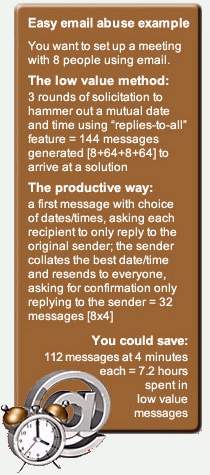I’m often asked to make presentations to groups on managing their workplace email. Here’s how I begin:
E-mail is an elusive time-thief
- 18% increase in corporate e-mail from 2004 to 2006, flat volumes 2007, 2008
- On average, 58 e-mails received, 37 sent per day
- It may take 4-5 minutes to process most e-mails, both received and sent
- Therefore, elapsed time to complete daily e-mails could be over 5 hours per day
E-mail has conflicts with humanity
- The technology is not the villain
- The way it is used by people is the villain
- The attitude it fosters is the villain
- The absorption of people by machines is the villain
And here’s how I end:
Out-of-office assistant: Best messages
I will be unable to delete all the unread, worthless emails you send me until I return from vacation on 10/27.
Please be patient an your mail will be deleted in the order it was received.
Out-of-office assistant: Best messages
Thank you for your email.
Your credit card has been charged $5.99 for the first 10 words and $1.99 for each additional word in your message.
Somewhere in the middle are the solutions
- Helping your organization get started
The hardest part in tackling workplace email is where to start and once started does it have an end?
When I work with organizations, I focus on isolating the 2 or 3 largest problems created through poor email use and develop solutions to correct the specific issues. Universally, workers want to improve email use. Taking some basic actions to correct/repair email misuse usually results in employees, managers, executives finding continued ways to improve and refine their email use. Most just need a start and that’s exactly what I provide.
- Creating awareness
We all know workplace email use is problematic and we are all curious about how we could do better. However, none of us want to spend a long time dwelling on how we use technology and how we communicate. My solution here is a 1 hour presentation on email productivity and how to think outside the inbox. The core presentation is the same, just customized slightly to take into account the specific audience and there generals issues.
-
A revolutionary learning tool
A 1-hour computer-based program designed to create greater productivity using email at work, based on the book “Managing Your E-mail: Thinking Outside the Inbox”, Copyright © 2003 Christina Cavanagh, John Wiley & Sons Ltd. This convenient, time-friendly approach employs a variety of learning and information methods, including lecture, quizzes and hands-on exercises. A unique feature of this tutorial is the articles that participants can download to use on an ongoing basis as personal reference materials.
Elearn program details
The content of this program is designed to be immediately applicable – one hour that will change the way you think, use and approach email. The program gives you:
Researched knowledge on workplace email
Exploration of causes and effects of poor email use
A combination of interactive and easily accessible solutions
Tips and techniques for better strategic and tactical use of email
Short, concise PDF download articles
The program has 9 sections:
Introduction & Quiz, Quirks and Wonders, The Legal Face of Email, The Inbox, The Outbox, Tips & Techniques, Email Conservation, Final Quiz, Summary. It also includes a unique elearn feature: 7 downloadable PDF articles to supplement your knowledge and refer back to for ongoing guidance.
Note to organizations: This program is SCORM compliant and compatible with Learning Management Systems.
Preview a Sample of the eLearn Program
Other references:
 See Christina Cavanagh's
author website
for articles from the Globe and Mail
See Christina Cavanagh's
author website
for articles from the Globe and Mail
Podcasts on email as posted on Forbes.com
Buy the book now at Amazon.com

